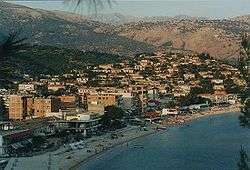Himarë (town)
| Himarë | |
|---|---|
| Town | |
 | |
 Himarë | |
| Coordinates: 40°6′5″N 19°44′48″E / 40.10139°N 19.74667°ECoordinates: 40°6′5″N 19°44′48″E / 40.10139°N 19.74667°E | |
| Country |
|
| County | Vlorë |
| Municipality | Himarë |
| Administrative Unit | Himarë |
| Time zone | CET (UTC+1) |
| • Summer (DST) | CEST (UTC+2) |
| Postal Code | 9425 |
| Area Code | 0393 |
| Vehicle registration | VL |
| Website | www.himara.gov.al |
Himarë (definite Albanian form: Himara) is a bilingual town in Southern Albania along the Albanian Riviera and part of the Vlorë County. It is the largest settlement and seat of the municipality of Himarë.[1] Both the town and municipality are populated by an ethnic Greek community.[2][3][4]
History
In antiquity the region was inhabited by the Greek tribe of the Chaonians.[5] The town of Himarë is believed to have been founded as Χίμαιρα,[6] (Chimaira,[7] hence the name Himara) by the Chaonians as a trading outpost on the Chaonian shore. However, another theory according to the name suggest that comes from Greek χείμαρρος (cheimarros), meaning "torrent".[8]
The town of Himara during the 16th-18th centuries was ecclesiastically under the jurisdiction of Rome, and some of its inhabitants were Catholics of the Eastern rite.[9]
See also
References
- ↑ Law nr. 115/2014
- ↑ Europa Publications Limited. Central and South-Eastern Europe 2004, Volume 5. Routledge, 2003. ISBN 978-1-85743-186-5, p. 78.
- ↑ Economist Intelligence Unit. (Great Britain). Country report: Albania, Issue 1., 2001.
- ↑ "Albania: The state of a nation" (PDF). ICG Balkans Report N°111. p. 15. Retrieved 2010-09-02.
The coastal Himara region of Southern Albania has always had a predominantly ethnic Greek population.
- ↑ Hammond, NGL (1994). Philip of Macedon. London, UK: Duckworth. "Epirus was a land of milk and animal products...The social unit was a small tribe, consisting of several nomadic or semi-nomadic groups, and these tribes, of which more than seventy names are known, coalesced into large tribal coalitions, three in number: Thesprotians, Molossians and Chaonians...We know from the discovery of inscriptions that these tribes were speaking the Greek language (in a West-Greek dialect)"
- ↑ An Inventory of Archaic and Classical Poleis: An Investigation Conducted by The Copenhagen Polis Centre for the Danish National Research Foundation by Mogens Herman Hansen, 2005, page 340.
- ↑ Chimaira, Henry George Liddell, Robert Scott, A Greek-English Lexicon, at Perseus
- ↑ Cheimarros, Henry George Liddell, Robert Scott, A Greek-English Lexicon, at Perseus
- ↑ Nilo Borgia: I monaci basiliani d'Italia in Albania: appunti di storia missionaria, secoli XVI-XVIII, periodo secondo. Reale Accademia d'Italia. Centro di studi per l'Albania. 1942. pp. 73, 113.
